At the beginning of the 20th century, a fascinating Russian autodidact, Konstantin Tsielkowski established not only that humanity will have sooner or later to spring towards the stars to meet other intelligent civilizations that must be out there, but also, he established a wealth of concepts, techniques, and proposed all kinds of solutions for the inhabited space flight on board rockets that would exist thereafter.
Tsielkowski had a fundamental influence on two men initially. One was the American Robert Goddard, who would try with a mitigated success to produce small experimental rockets, testing them almost alone and in a secret before World War II in the desert of New Mexico, United States, right in the North of... Roswell.
The other was a German scientist, Hermann Oberth (1894-1989), who in 1923 wrote a seminal book, «Die Rakete zu den Planetenräumen» (rockets towards the planets) which would get avid readership and resulted indeed in the construction of rockets. The book predicted practically all the current astronautics: rockets, satellites, the trip to the Moon, space stations, space probes towards other planets.
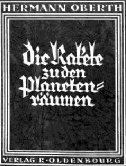
|
Above: Oberth's book.
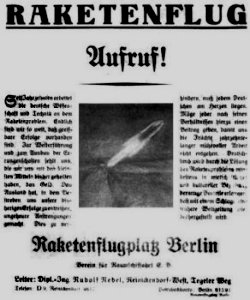
|
Above: The call by the Rocket Club in 1927.
An association of amateurs and scientists, among those Oberth, obviously, a «Club of the Rockets», was then quickly established, and they built small rockets and made all kinds of theoretical calculations but also of tests. The Club reached a membership of more than 500 people.
In 1928, Oberth even helps the famous movie director Fritz Lang to give a realistic touch to the first movie about a rocket trip to the moon in history, «Frau im Mond» (a woman on the Moon). The rocket, in the movie, is named «Friede», Peace... The movie inaugurates the tradition of the «countdown», and the liquid propellant three stages rocket model built by Oberth for the movie was so much carefully designed that the Nazis would confiscate it as soon as they started to plan to use rockets as weapons of destruction!
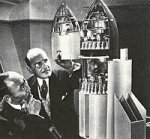
|
Above: The rocket in the movie
«Frau im Mond.»
Among the Rockets Club member was Werner von Braun (1912-1977), the father of the V-2, who would be engaged by the American after the war within the framework of project «Paperclip» which made sure that the top German researchers and spies would join the USA rather than the Soviet world. Von Braun pursued on their premises his initial dream inspired by Oberth: not to build weapons of destruction, but space rockets to bring man on other planets. Everyone knows that this ultimately resulted in the landings of man on the Moon. It is interesting to note that Oberth publicly stated many times his opinion that the flying saucers are real and extraterrestrial, and von Braun as well of others working on advanced projects were not unaware of this opinion.
Another member of the Rockets Club was an Austrian engineer of the name of Helmut Graf von Zborowski. During World War II, he, as these other talents, was assigned to the creation of «last chance» weapons for Germany. In 1944, he was at the BMW with the factory of Allach, chief of a rocketry study group with the rank of Lieutenant of the SS. He worked on the Walter rocket engine the of Messerschmitt Me-163 «Komet». In a separate part of the installations, he made research on new air weapons, as he did not concentrate solely on rockets. The BMW new weapons workshop was moved to Zühlsdorf then to Bruckmühl close to Rosenheim in 1945. After the war, he was captured by the French instead of the Americana, and was confined in secrecy in a castle close to Paris so that he would pass on to France his knowledge and would continue his research. Technically valued but politically embarrassing, he would be brought back to Bonn in Germany later when his knowledge was entirely handed over.
Around Zborowski, arrived with his valued knowledge on the engines and his interest for exotic propulsions, ramjet, rocket, and an idea quite as exotic, that of the annular wing, the French very discreetly set up the BTZ, in the Castle of Brunoy right in the South of Paris.
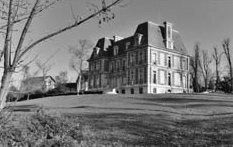
|
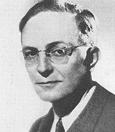
|
Official history thus reports that the Technical Office Zborovski, or «Bureau Technique Zborovski», was opened in France by an Austrian, Helmut Graf von Zborowski, in 1950, to study the concept of vertical takeoff and landing (VTOL) planes, and the annular wing.
In addition to the obvious advantages of vertical takeoff, the awaited benefit were an important reduction of the weight of the plane, an aerodynamic effectiveness at high speed, and because of high speeds and weak weight in comparison with the push, a long operating range.
Also in consideration were the tactical advantages of such a machine. It could take off from anywhere, and it was well known that in the event of war the traditional airfield strips would very quickly be destroyed. It could be transported by truck using normal roads. Going up vertically, it would have a very interesting climbing speed for interceptions missions of enemy bombers above the country.
An annular wing does not really have any appreciable quality at low speed. But after all, if the takeoff is vertical with the push of the propulsion system alone, without at all counting on wings lift at the time of takeoff, this shortcoming of the annular wing disappears and there remains only its qualities at high speed. Of course, it creates many issues, in particular that of the transition between vertical takeoff and level flight, but BTZ intended to try to solve these problems.
In afterthought, there was also the idea that the tube which forms the annular wing could be the very structure for what the modern aeronauticians calls a ramjet and that we call in France «statoréacteur», i.e. jet with no moving parts. A ramjet is nothing more than an empty tube, in air enters, in which fuel is vaporized and exploded, which provides a push as in the traditional jet engines. The advantage is simplicity and effectiveness at high speed, without all the fast rotating parts used in a traditional jet engine to compress the air. The drawback is that the ramjet cannot take off all alone: it functions only when sufficient speed is already reached so that air enters with no help and in sufficient quantity in the ramjet. At the BTZ, it was thought that if an annular winged plane with propellers or traditional engine was realizable, benefiting from the tube which constitutes the annular wing to make use of it as ramjet would be a logical continuation, and would lead to an aeronautical dream: planes capable of strong bursts of speed while being also capable of vertical takeoff and hovering.
Other solutions would be tested with relative success in France by Leduc: to provide its initial speed to the ramjet plane by launching it from a carrier aircraft, or to equip it in addition with a traditional jet engine or rocket for takeoff. But that's another story.
The BTZ studied the concept of the annular wing at the same time with a view to produce manned planes and to produce planes without pilot, which at the time weren't yet called drones.
Here are blueprints of some of the craft being studied at the BTZ:
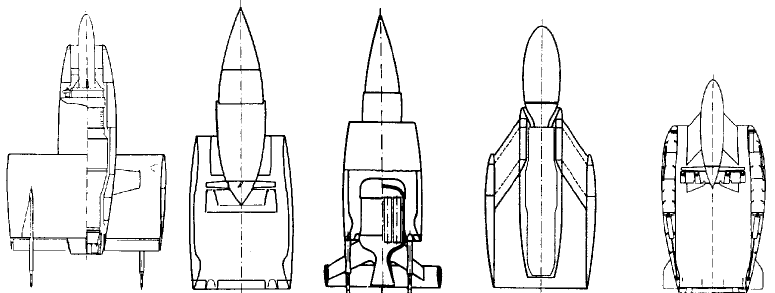
From left to right above:
Around the annular wing concept, all the uses would be approached with the BTZ, from the interceptor to the private plane.
It is important to note that all the craft presented here existed only on paper or as non-flying models. None flew, none was mistaken as UFO. Only one of these concepts would briefly fly, and this will be told later on in part II.
The first controlled model studied was called baptized «Hanneton IS» (Cockchafer, below). It was a single-seater, with two turbines having each one two contrarotating coaxial fans.

|
Hanneton IS was followed of the Hanneton II concept: this time, there are three seats, two Turboméca turbines having each one two contrarotating coaxial fans, one has two blades and the other three blades. It was estimated that it could reach 280 miles per hour and have a range of 620 miles. The machine was to be 19 feet length on a diameter of 20 feet.
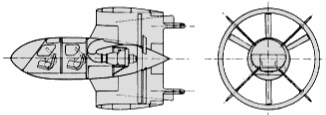
|
There will be then a new version Hanneton III: There are always three places, the two turbines are of Turboméca Marcadau II having each one two contrarotating coaxial propellers, of three blades each one. It is estimated that it will reach the 650 miles per hour and will have a range of 1200 kilometers. The machine is 7 meters long for a diameter of 3 meters.
 |
This time, BTZ goes beyond the drawing and builds a wood model (Right).
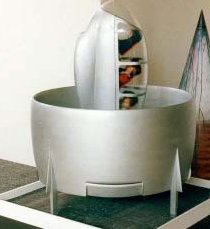
|
Enthusiasm and ambition being, it is a version IIIA of the Hanneton appears.
There are now six rocking seats, the two turbines are Turboméca Artouste III, it has two contrarotating coaxial fans of three blades each. It is estimated that it should reach 600 kilometers per hour and will have an amazing autonomy of 2400 kilometers. Its length is 5 meters and the diameter 4 meters 20.
Again the BTZ goes beyond the drawing and builds a scaled down model out of wood.
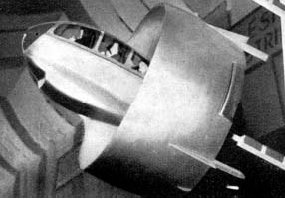 |
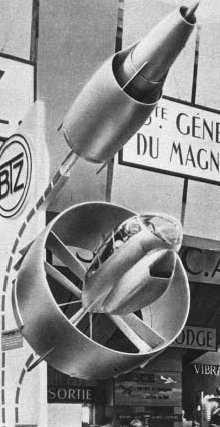
|
Incredible as it may seem there was a Hanneton 7C seven seater with two turbines Turboméca Turmo III, then a Hanneton IV 12 seater with a double Mamba turbojet (Right).
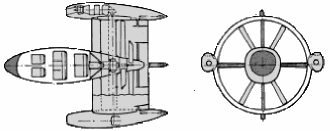
|
And finally, disproportion seems reached with Hanneton 20C and its 20 seats in two cabins on both sides of the annular wing!
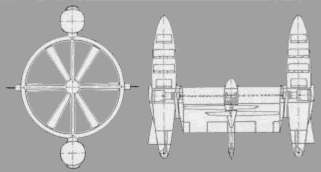
|
Since BTZ engineers thought of placing two cabins around one annular wing, very expectedly, they also considered two annular wings around one cabin.
That would be the Lucane concept:

|
Lucane would be one line followed by the Americans later, with a whole series of prototypes with tilting wing, Bell Model 65, Bell XV-3, Curtiss X-19, Ryan XC-14A, Bell X-22, and finally the V-22 Osprey which was the best result: the whole wing tilts between the horizontal and the vertical directing the annular wings that are more ducted fans than wings - or traditional fans or rotors. The takeoff is nearly vertical, but in flight the bridge between the annular wings or the rotors ensures an appreciable lift.
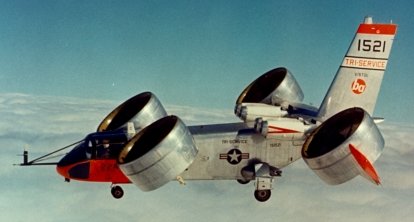
|
Scarabée (Beatle) follows. This time, it is a reconnaissance and ground attack two-seater, equipped with 4 Turboméca Turmo IV operating two contrarotating coaxial propellers of two blades each:
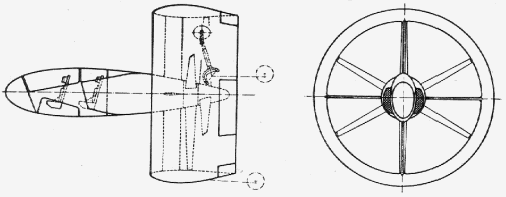
The craft was to weigh 7 tons and be able to carry a half-ton of weaponry at a speed of 600 km/h for 6 hours missions.
Lastly, a slightly supersonic ground attack and interceptor craft with annular wing is studied. The single-seat Bruche (another beetle), is propelled by ramjet in cruising but is equipped in addition with an Atar 101 jet which would ensure that it reaches 900 miles per hour with afterburner. It was to measure 27 feet in length and 9 feet in diameter.
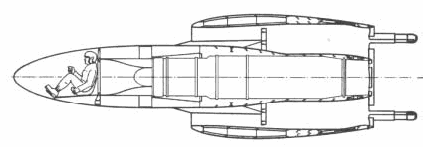
|
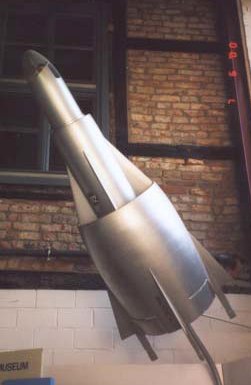
|
The annular wing concept and all those potential use are then licensed to SNECMA in 1951.
And then, prototyping started.
It is important to note that the craft was not secret. For example, Le Courrier de Saône-et-Loire, France, page 7, on October 19, 1954., reported:
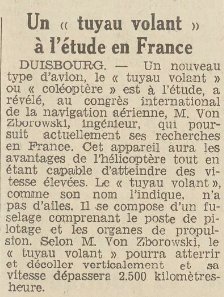
|
DUISBURG. -- A new type of aircraft, the "flying pipe" or "coleopter", is under development, revealed Mr. Von Zborowski, an engineer currently conducting research in France, at the international congress of air navigation. This craft will have the advantages of a helicopter while also being able of reaching high speeds. The "flying pipe," as its name suggests, has no wings. It consists of a fuselage containing the cockpit and propulsion system. According to Mr. Von Zborowski, the "flying pipe" will be able to take off and land vertically, and its speed will exceed 2,500 kilometers per hour.
To be continued...
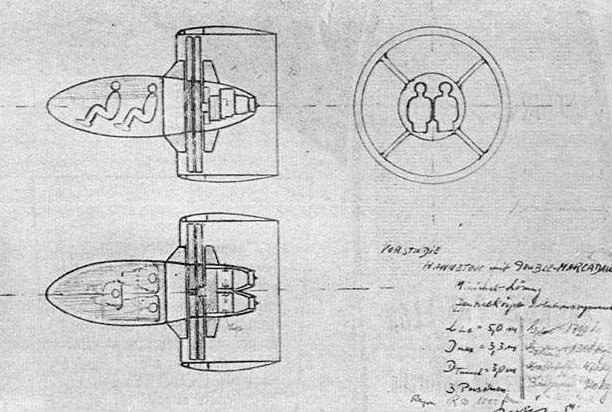
|
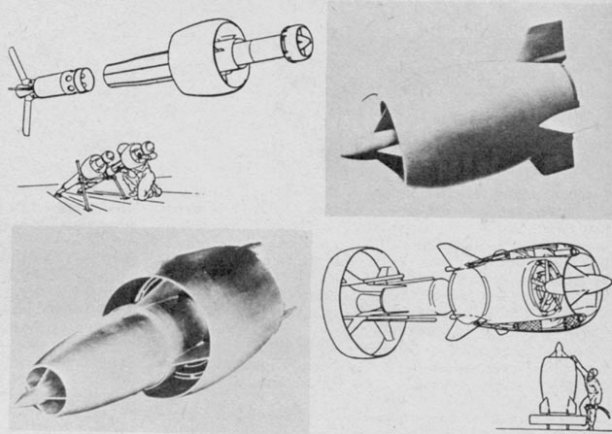
|